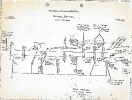Fairbanks-Morse: H24-66 "Train Master"
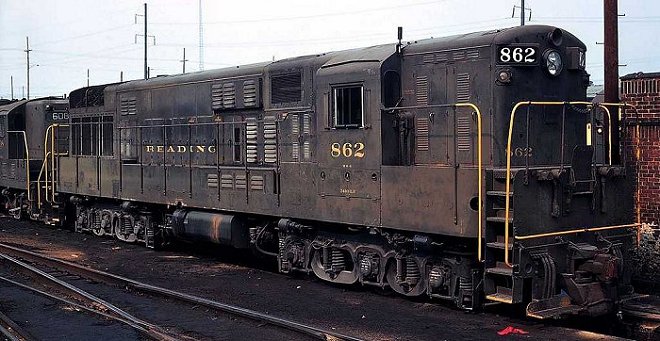
To complete its transition to diesel motive power, the Reading began purchasing Fairbanks-Morse "Trainmaster" locomotives in April, 1953. Officially designated "H24-66" (Hood, 2400 hp, 6 motors, 6 axles) locomotives, these units were the largest and heaviest single-unit diesel locomotives on the Reading at the time. They were also the first six-axle diesels purchased by the Reading. With their high horsepower, the Trainmasters were able to power a same train that normally took at least 2 four-axle units. The Reading tested FM's Trainmaster demonstrator units across the system during July of 1953. In an odd twist, the Reading submitted their order in April, even before the demonstrators had arrived!
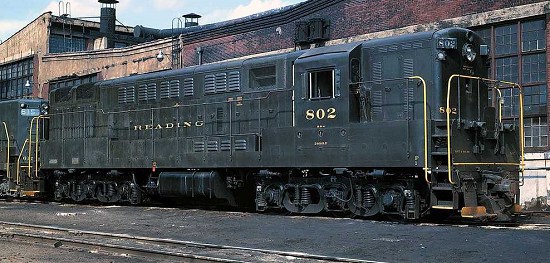 The first units to arrive, 800-801, went into service in October of 1953 and were classed RS-4. Locomotives 860 and 861 arrived at the same time, and were delivered with steam generators for passenger service. Trainmasters in the 860 series were given the designation RS-4b. In late October/early November, units 802-806 arrived at Rutherford. Upon entry into service, these units replaced some of the Reading's remaining I-9 and I-10 Consolidation steam locomotives. The final Trainmaster Locomotives, units 807, 808, and 862 through 867, were delivered in 1955-1956. These were the final first-generation diesel power purchased by the Reading.
The first units to arrive, 800-801, went into service in October of 1953 and were classed RS-4. Locomotives 860 and 861 arrived at the same time, and were delivered with steam generators for passenger service. Trainmasters in the 860 series were given the designation RS-4b. In late October/early November, units 802-806 arrived at Rutherford. Upon entry into service, these units replaced some of the Reading's remaining I-9 and I-10 Consolidation steam locomotives. The final Trainmaster Locomotives, units 807, 808, and 862 through 867, were delivered in 1955-1956. These were the final first-generation diesel power purchased by the Reading.
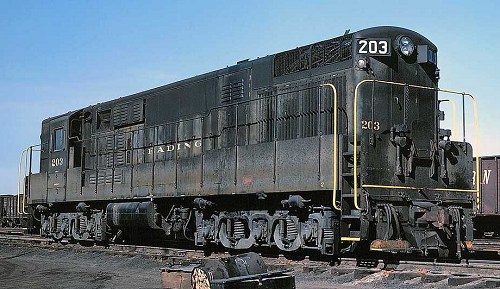 All units were delivered in the Reading's standard Pullman green paint scheme with end and corner handrails painted yellow for safety. As was customary on the Reading, these locomotives initially ran long hood forward. However, in 1959 the short hood was designated as the front end. Since some units had dual controls, this was merely a change in designation, while other units had their control stands moved to accomodate the change. The freight units also had dynamic brakes and a larger fuel tank rated at 4200 gallons. While the passenger units in the 860 series did not have dynamic brakes, they did have dual control stands. Two Trainmasters were assigned to the east hump at Rutherford Yard, while roughly a half dozen units were placed in mine drag service operating out of St. Clair. The passenger units were most often seen operating on Bethlehem Branch trains, where they replaced paired sets of Alco RS-3s and Baldwin AS-16s, releasing these units for other duties. Trainmasters also worked in freight service at Bethlehem, as their brute strength allowed them to deal with the many loads of ore and coal for the furnaces.
All units were delivered in the Reading's standard Pullman green paint scheme with end and corner handrails painted yellow for safety. As was customary on the Reading, these locomotives initially ran long hood forward. However, in 1959 the short hood was designated as the front end. Since some units had dual controls, this was merely a change in designation, while other units had their control stands moved to accomodate the change. The freight units also had dynamic brakes and a larger fuel tank rated at 4200 gallons. While the passenger units in the 860 series did not have dynamic brakes, they did have dual control stands. Two Trainmasters were assigned to the east hump at Rutherford Yard, while roughly a half dozen units were placed in mine drag service operating out of St. Clair. The passenger units were most often seen operating on Bethlehem Branch trains, where they replaced paired sets of Alco RS-3s and Baldwin AS-16s, releasing these units for other duties. Trainmasters also worked in freight service at Bethlehem, as their brute strength allowed them to deal with the many loads of ore and coal for the furnaces.
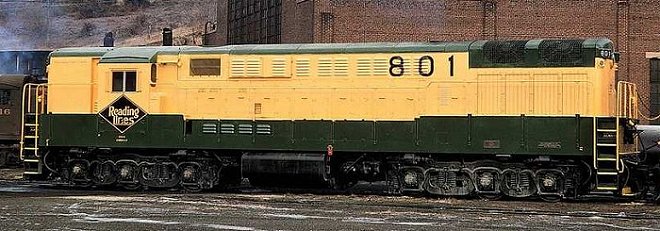
In the early 1960s, as second generation motive power began service on the Reading, the Fairbanks-Morse Trainmasters were often paired with those units and operated more frequently in mainline freight service, particularly on crossline runs between Rutherford and Allentown. Despite their high horsepower and rapid acceleration, the Reading's fleet of Trainmasters began to dwindle with retirements starting in the mid/late 1960s. Locomotive #804 was the victim of the huge fire at the Gettysburg Freight House (along with GP-7 #612) in 1966, and #807 was scrapped in January, 1968. Prior to this, Trainmasters #801 and #867 were repainted into the 1960s yellow-and-green paint scheme. The remaining units were renumbered in 1967 per the chart below:
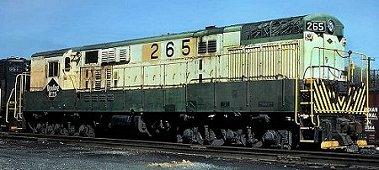 |
|
Some confusion arose as a result of the renumbering - since #801 and #867 had been repainted, then renumbered, some people thought there were actually four yellow-and-green TMs in service instead of only two. From 1968 through 1970, the retirements and scrapping continued, until June of that year when the final units left the property.
MODELING NOTES: The first group of Trainmasters (800-801 & 860-861) were "Phase 1b" style. The remaining unites were "Phase 2" units. The main spotting difference is that the Phase 1b units had a 9" space between the rooftop fans on the long hood, while the Phase 2 units did not. Also, the Phase 2 units had five rows of louvers/vents on the top side of the long hood. The horns used on the Trainmasters were WABCo H-6 type - one was recessed in the end of the short hood while the other was mounted on the side of the long hood in front of the engineer's side of the cab. Also take note of other details from the photos above such as placement of the firecracker radio antenna. Athearn has had a Trainmaster locomotive for many years, though they may now be hard to find. You would have to paint and decal one of these, as they were never available factory-painted for the Reading. Atlas now makes a very nicely detailed Train Master in both the Pullman green and the yellow-and-green schemes. These units are DCC ready with a 8 pin plug, and the "Gold Series" is sound-equipped.
Did You Know?
Downloads
 A variety of Reading Company operations related documents, etc. that may be of use in your modeling efforts.
A variety of Reading Company operations related documents, etc. that may be of use in your modeling efforts.
 A variety of Reading Company operations paperwork, such as train orders, clearance forms, etc. that will help you operate your Reading layout in a prototypical manner.
A variety of Reading Company operations paperwork, such as train orders, clearance forms, etc. that will help you operate your Reading layout in a prototypical manner.
 Public Timetables, Employe Timetables, and Rulebooks that provide much useful operational information.
Public Timetables, Employe Timetables, and Rulebooks that provide much useful operational information.
 Signs, billboards, and other FREE goodies for your use. We ask only that you help spread the word about The Reading Modeler!
Signs, billboards, and other FREE goodies for your use. We ask only that you help spread the word about The Reading Modeler!

